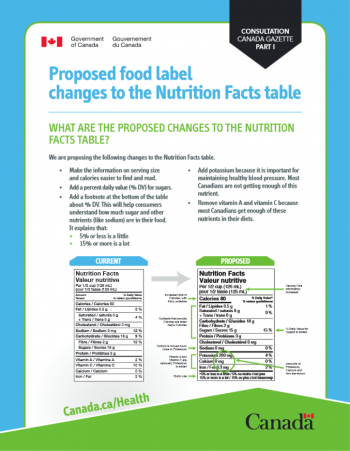15 Proposed Changes to Labelling
Food labelling is a shared responsibility between Health Canada and the Canadian Food Inspection Agency (CFIA). Currently, there is an effort to improve food labelling to make labels easier to understand. Once the proposed regulations take effect, food manufacturers will incur the cost of changing their packaging to comply. For example, proposed changes will show serving sizes that are closest to the reference amount and should, if possible, be the same weight so consumers can make a quick comparison in nutritional value.
Health Canada is also proposing new serving guidelines in order to make comparing food products easier. Currently, for example, a serving size of one or two slices of bread may vary greatly in weight, thus making it difficult to compare the nutritional value of similar products. The proposed change is to have a serving size of bread be two slices, as Health Canada claims that most people eat two slices of bread in one serving. Other proposed changes are how micronutrients will be listed. For example, vitamin D and potassium will be mandatory, but not vitamins A and C, and the listing of iron and calcium will remain the same.
Another proposed change is for the labelling of sugar, which will now be listed as added sugar. As sugar consumption in Canada is an ongoing concern, Health Canada has suggested listing all sugars under the common name “sugar” and in descending order. Some of the common sugars are honey, molasses, glucose, and fructose. In addition, Health Canada proposes to establish a daily value of sugar consumption in the nutrition facts tables (NFT) of 100 g, arguing that “approximately half of Canadians consume more than 20% of their energy as sugars, with the highest intakes reported in younger age groups (<19 years)” (Health Canada, 2014). The proposed amount is double the World Health Organization’s recent recommendation of a total daily energy intake of 10% sugar.
These changes will result in added costs for food manufacturers, including bakers, as they implement new labelling and revise the nutritional analyses of their products.
Figure 3 compares the current NFT with the proposed one.

Changes or improvements to the nutrition facts tables have not been finalized yet, but the aim is to have the new regulations implemented sometime in 2015. The application of the new labelling policy may be at a later date as the proposed changes have only completed the consultation and consumer feedback stage. A full report is available on Health Canada’s website under What We Heard.
For more general information, see Health Canada, Food and Nutrition.

